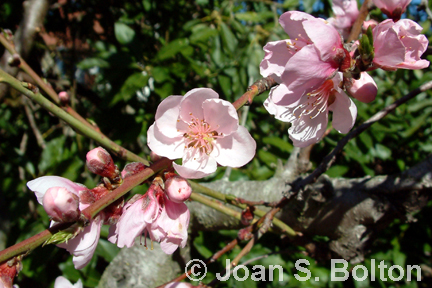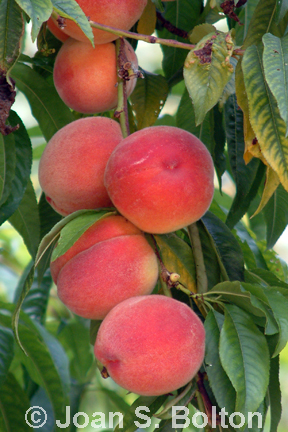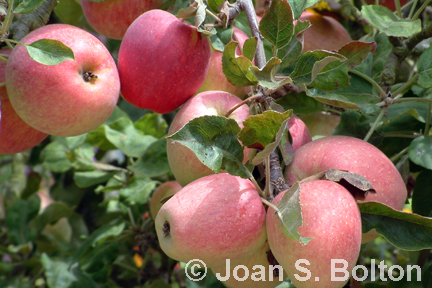
Bare-root season is not just for roses.
Deciduous fruit trees go dormant, too, and are equally accepting of being dug up, having the soil removed from their roots and then being transported to nurseries where they’re available now.
Remarkably, within a few years these stick-like plants will grow rapidly, bud out and produce delicious, tree-ripened fruit. Your choices include apple, apricot, cherry, fig, mulberry, nectarine, nectaplum, peach, pear, persimmon, plum, pluot and pomegranate trees as well as almond, pistachio and walnut trees.
But first, as with roses, you’ll find nondescript, tan or gray bundles of trunks, branches and twigs stuck in bins filled with moist sand or sawdust to protect their dormant, stringy roots. As with roses, you’ll likely see enticing photos posted above each. And as with roses, it’s critical to read the descriptions to make sure that whatever you take home can be expected to thrive in your garden.
Consider the Chill

Your most important factor at the nursery is how much cold a particular tree needs to properly set fruit. Cold is calculated by measuring chill hours, which are the number of hours the temperature drops below 45 degrees between November 1 and February 28.
That number is key because many pome and stone fruit trees require more chill hours than certain Central Coast neighborhoods offer.
For example, some apples, cherries and pears require 1,100 to 1,500 chill hours, yet our mildest, coastal areas rarely get more than 300 chill hours. You have far more options if you live in the Santa Ynez Valley, which accumulates at least 1,000 chill hours most years.
UC Davis compiles the numbers, and this season has proved chilly so far. As of February 2, Santa Maria reported 593 chill hours; Lompoc, 832; Santa Ynez, 1,035; Nipomo, 630; and Santa Barbara, 312.
Selecting Stock
After narrowing your choices, gently tug a tree out of its bin and check for the following:
The roots should be plump, hairy and evenly spaced, not shriveled or lopsided.
The bud union, where the root stock is grafted to the bearing wood, should appear smooth and strong.
The trunk should measure 1/2 to 5/8ths of an inch in diameter. Smaller than that may result in poor growth; any larger, and it may not be in balance with the roots.
Any limbs should flex easily. If they snap, they’re probably dead.
The branching structure — unless it’s entirely out of whack — is not as important. You’ll be trimming the top and side shoots after planting.
Selecting the Site

Sunlight, good drainage, wind protection and the coldest spot in your garden are all key.
Fruit trees need at least six hours of direct sunlight to stimulate buds and develop mature fruit. That direct light is most important during the growing season. It’s not a problem if the sun swings low in the dead of winter.
However, good drainage is important year-round. If water puddles where you plan to plant, shape a mound at least a foot tall or build a raised bed.
Fruit trees don’t like wind, especially when they’re budding out in late winter and early spring, and again when the fruit is beginning to mature. Fierce winds can literally blow off buds and rip off ripening fruit.
As for that all-important chill: avoid planting your bare-root fruit trees up against your house, driveway or patio, as all three can radiate considerable warmth. Instead, seek a low spot where cold collects.
Planting Time

Dig a hole as deep as your tree’s roots and at least three times as wide.
It’s fine to work in compost over the general planting area. But don’t worry about amending the hole. Instead, just break up any clods, line the hole with quarter-inch aviary wire if gophers are a problem, then form a dirt cone on the bottom of the hole to support the roots.
Pack down the cone and set the tree on top. Orient the bud union so that the flat notch faces the north or northeast, to prevent sun damage. Start filling the hole.
If you’re not sure how deep to plant the tree, lay a shovel across the hole. Look for the faint soil line on the trunk, then hold the tree over the hole to see how that soil line matches with the existing soil.
Plant your tree an inch or two high, to allow for settling. Ideally, the bud union will end up sitting 3 to 5 inches above the soil line, while the uppermost of the largest, thickest roots will be buried several inches below.
Shape a watering basin about a foot away from the trunk. Apply an inch or two of mulch, avoiding direct contact with the trunk. Then soak the tree.
Don’t fertilize. The tree possesses sufficient energy in its tissues to break dormancy, and any salt in the fertilizer may burn emerging roots.
Shape Up Your Tree

Once your tree is in the ground, it’s time to prune.
Most likely, your tree is composed of a whip and possibly a few side branches. Despite its paltry size, you still need to trim it in order to initiate good branching. Cut off the top about a quarter inch above a bud that’s 30 to 36 inches above the ground.
Then trim any side branches to 3-inch stubs bearing two or three buds.
In no time, it should start sending out whips and shoots in every direction. Toward the end of summer, prune your developing tree with an eye toward its future framework. Cut back new growth by up to a half in order to encourage evenly spaced, strong, balanced branches and to maintain plenty of air flow through the tree.
Some folks advocate keeping fruit trees compact and bush-like so that they’re easier to care for and harvest. If you’d like to adopt that technique, often referred to as Backyard Orchard Culture, trim your tree to 18 to 24 inches at planting time, to force lower, bushier branching. Then cut it back twice — by half in late spring, and by half again in late summer.
≈
Watering Your Fruit Trees
While you should keep the soil moist if winter rains don’t oblige, new, bare-root fruit trees don’t require a lot of supplemental water until temperatures warm up and new growth takes off.
According to UC Cooperative Extension, a healthy, first-year fruit tree that’s not mulched needs 5 to 10 gallons of water a week during the summer, and much less water if it is mulched.
Obviously the amount of water that a new fruit tree in your own garden needs depends greatly on your soil type, air temperature, sun exposure and overall conditions.
It’s okay to let the top couple of inches of soil dry out between waterings. But the soil further down in the root zone should stay moist. Use a soil moisture probe or dig down 4 to 6 inches with a screwdriver or hand weeder occasionally to check.
When you do irrigate, use drip irrigation, attach a bubbler to your hose or set your faucet to a trickle so that the water flows out slowly and gives your tree a deep soak, rather than a quick blast solely to the surface.
≈
Seeds of Wisdom
If recent rains have made your soil too wet to dig, put your bare-root tree in a bucket filled with moist sand, sawdust or even shredded newspapers. Set the tree in a shady spot out of the wind and keep the temporary mix damp but not soggy.
≈
Copyright, Joan S. Bolton. All rights reserved. Reproduction of text or photos in any form is prohibited without written permission.
≈
